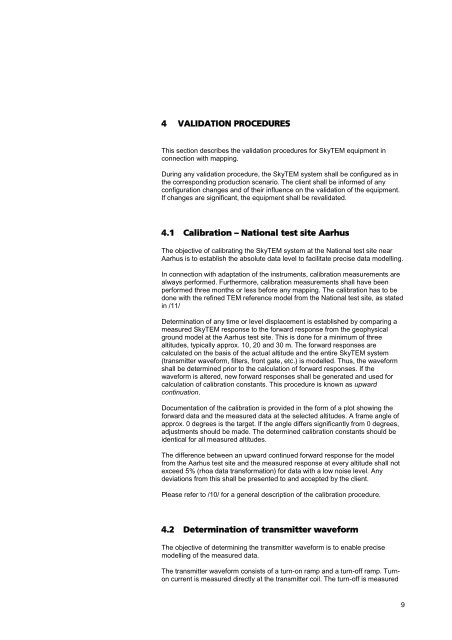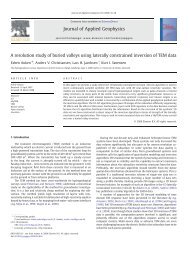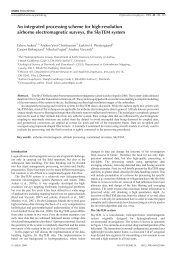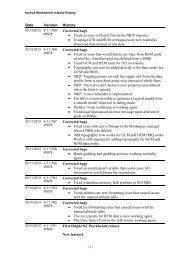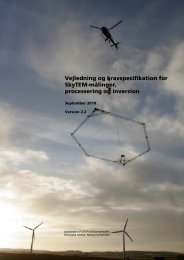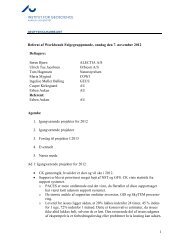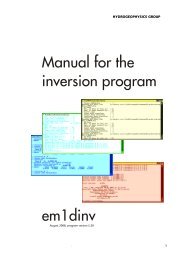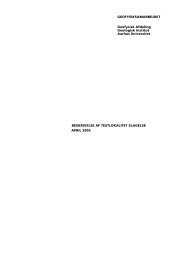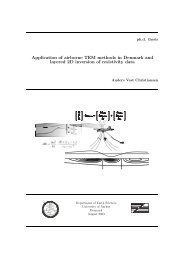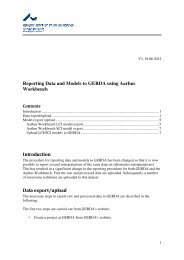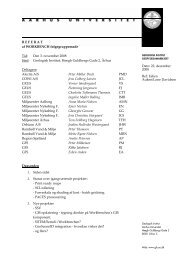guideline and standards for skytem measurements, processing and ...
guideline and standards for skytem measurements, processing and ...
guideline and standards for skytem measurements, processing and ...
Create successful ePaper yourself
Turn your PDF publications into a flip-book with our unique Google optimized e-Paper software.
4 VALIDATION PROCEDURES<br />
This section describes the validation procedures <strong>for</strong> SkyTEM equipment in<br />
connection with mapping.<br />
During any validation procedure, the SkyTEM system shall be configured as in<br />
the corresponding production scenario. The client shall be in<strong>for</strong>med of any<br />
configuration changes <strong>and</strong> of their influence on the validation of the equipment.<br />
If changes are significant, the equipment shall be revalidated.<br />
4.1 Calibration – National test site Aarhus<br />
The objective of calibrating the SkyTEM system at the National test site near<br />
Aarhus is to establish the absolute data level to facilitate precise data modelling.<br />
In connection with adaptation of the instruments, calibration <strong>measurements</strong> are<br />
always per<strong>for</strong>med. Furthermore, calibration <strong>measurements</strong> shall have been<br />
per<strong>for</strong>med three months or less be<strong>for</strong>e any mapping. The calibration has to be<br />
done with the refined TEM reference model from the National test site, as stated<br />
in /11/<br />
Determination of any time or level displacement is established by comparing a<br />
measured SkyTEM response to the <strong>for</strong>ward response from the geophysical<br />
ground model at the Aarhus test site. This is done <strong>for</strong> a minimum of three<br />
altitudes, typically approx. 10, 20 <strong>and</strong> 30 m. The <strong>for</strong>ward responses are<br />
calculated on the basis of the actual altitude <strong>and</strong> the entire SkyTEM system<br />
(transmitter wave<strong>for</strong>m, filters, front gate, etc.) is modelled. Thus, the wave<strong>for</strong>m<br />
shall be determined prior to the calculation of <strong>for</strong>ward responses. If the<br />
wave<strong>for</strong>m is altered, new <strong>for</strong>ward responses shall be generated <strong>and</strong> used <strong>for</strong><br />
calculation of calibration constants. This procedure is known as upward<br />
continuation.<br />
Documentation of the calibration is provided in the <strong>for</strong>m of a plot showing the<br />
<strong>for</strong>ward data <strong>and</strong> the measured data at the selected altitudes. A frame angle of<br />
approx. 0 degrees is the target. If the angle differs significantly from 0 degrees,<br />
adjustments should be made. The determined calibration constants should be<br />
identical <strong>for</strong> all measured altitudes.<br />
The difference between an upward continued <strong>for</strong>ward response <strong>for</strong> the model<br />
from the Aarhus test site <strong>and</strong> the measured response at every altitude shall not<br />
exceed 5% (rhoa data trans<strong>for</strong>mation) <strong>for</strong> data with a low noise level. Any<br />
deviations from this shall be presented to <strong>and</strong> accepted by the client.<br />
Please refer to /10/ <strong>for</strong> a general description of the calibration procedure.<br />
4.2 Determination of transmitter wave<strong>for</strong>m<br />
The objective of determining the transmitter wave<strong>for</strong>m is to enable precise<br />
modelling of the measured data.<br />
The transmitter wave<strong>for</strong>m consists of a turn-on ramp <strong>and</strong> a turn-off ramp. Turnon<br />
current is measured directly at the transmitter coil. The turn-off is measured<br />
9


